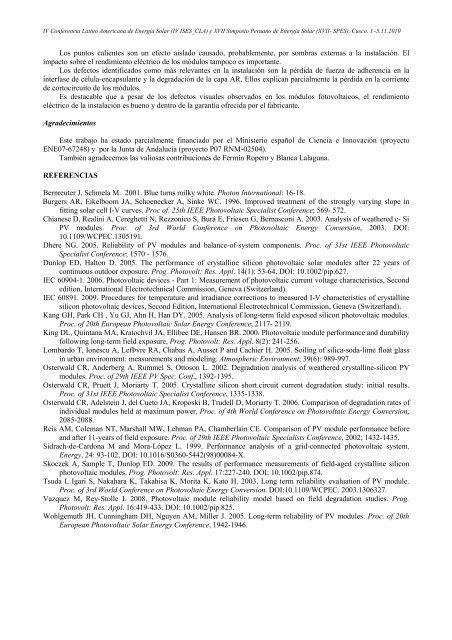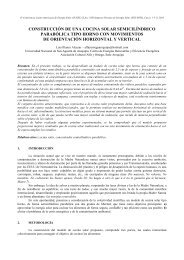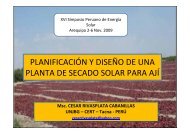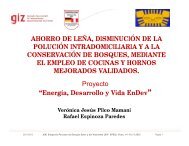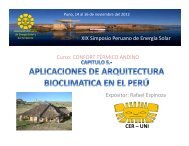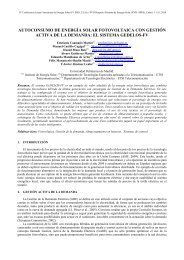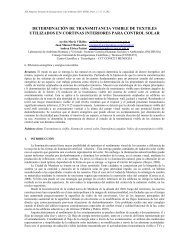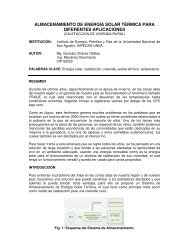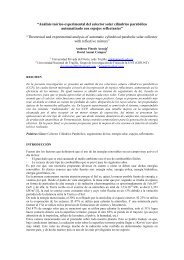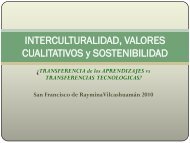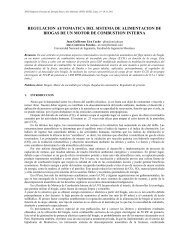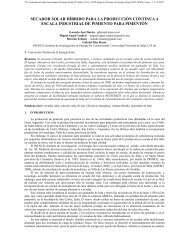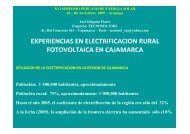degradación de módulos fotovoltaicos de silicio cristalino tras 12 ...
degradación de módulos fotovoltaicos de silicio cristalino tras 12 ...
degradación de módulos fotovoltaicos de silicio cristalino tras 12 ...
Create successful ePaper yourself
Turn your PDF publications into a flip-book with our unique Google optimized e-Paper software.
IV Conferencia Latino Americana <strong>de</strong> Energía Solar (IV ISES_CLA) y XVII Simposio Peruano <strong>de</strong> Energía Solar (XVII- SPES), Cusco, 1 -5.11.2010Los puntos calientes son un efecto aislado causado, probablemente, por sombras externas a la instalación. Elimpacto sobre el rendimiento eléctrico <strong>de</strong> los <strong>módulos</strong> tampoco es importante.Los <strong>de</strong>fectos i<strong>de</strong>ntificados como más relevantes en la instalación son la pérdida <strong>de</strong> fuerza <strong>de</strong> adherencia en lainterfase <strong>de</strong> célula-encapsulante y la <strong><strong>de</strong>gradación</strong> <strong>de</strong> la capa AR. Ellos explican parcialmente la pérdida en la corriente<strong>de</strong> cortocircuito <strong>de</strong> los <strong>módulos</strong>.Es <strong>de</strong>stacable que a pesar <strong>de</strong> los <strong>de</strong>fectos visuales observados en los <strong>módulos</strong> <strong>fotovoltaicos</strong>, el rendimientoeléctrico <strong>de</strong> la instalación es bueno y <strong>de</strong>ntro <strong>de</strong> la garantía ofrecida por el fabricante.Agra<strong>de</strong>cimientosEste trabajo ha estado parcialmente financiado por el Ministerio español <strong>de</strong> Ciencia e Innovación (proyectoENE07-67248) y por la Junta <strong>de</strong> Andalucía (proyecto P07 RNM-02504).También agra<strong>de</strong>cemos las valiosas contribuciones <strong>de</strong> Fermín Ropero y Blanca Lalaguna.REFERENCIASBernreuter J, Schmela M. 2001. Blue turns milky white. Photon International: 16-18.Burgers AR, Eikelboom JA, Schoenecker A, Sinke WC. 1996. Improved treatment of the strongly varying slope infitting solar cell I-V curves. Proc of. 25th IEEE Photovoltaic Specialist Conference; 569- 572.Chianese D, Realini A, Cereghetti N, Rezzonico S, Burá E, Friesen G, Bernasconi A. 2003. Analysis of weathered c- SiPV modules. Proc. of 3rd World Conference on Photovoltaic Energy Conversion, 2003. DOI:10.1109/WCPEC.1305191.Dhere NG. 2005. Reliability of PV modules and balance-of-system components. Proc. of 31st IEEE PhotovoltaicSpecialist Conference; 1570 - 1576.Dunlop ED, Halton D. 2005. The performance of crystalline silicon photovoltaic solar modules after 22 years ofcontinuous outdoor exposure. Prog. Photovolt: Res. Appl. 14(1): 53-64, DOI: 10.1002/pip.627.IEC 60904-1. 2006. Photovoltaic <strong>de</strong>vices - Part 1: Measurement of photovoltaic current voltage characteristics, Secon<strong>de</strong>dition, International Electrotechnical Commission, Geneva (Switzerland).IEC 60891. 2009. Procedures for temperature and irradiance corrections to measured I-V characteristics of crystallinesilicon photovoltaic <strong>de</strong>vices, Second Edition, International Electrotechnical Commission, Geneva (Switzerland).Kang GH, Park CH , Yu GJ, Ahn H, Han DY. 2005. Analysis of long-term field exposed silicon photovoltaic modules.Proc. of 20th European Photovoltaic Solar Energy Conference; 2117- 2119.King DL, Quintana MA, Kratochvil JA, Ellibee DE, Hansen BR. 2000. Photovoltaic module performance and durabilityfollowing long-term field exposure, Prog. Photovolt: Res. Appl. 8(2): 241-256.Lombardo T, Ionescu A, LefÞvre RA, Chabas A, Ausset P and Cachier H. 2005. Soiling of silica-soda-lime float glassin urban environment: measurements and mo<strong>de</strong>ling. Atmospheric Environment; 39(6): 989-997.Osterwald CR, An<strong>de</strong>rberg A, Rummel S, Ottoson L. 2002. Degradation analysis of weathered crystalline-silicon PVmodules. Proc. of 29th IEEE PV Spec. Conf., 1392-1395.Osterwald CR, Pruett J, Moriarty T. 2005. Crystalline silicon short.circuit current <strong>de</strong>gradation study: initial results.Proc. of 31st IEEE Photovoltaic Specialist Conference, 1335-1338.Osterwald CR, A<strong>de</strong>lstein J, <strong>de</strong>l Cueto JA, Kroposki B, Tru<strong>de</strong>ll D, Moriarty T. 2006. Comparison of <strong>de</strong>gradation rates ofindividual modules held at maximum power. Proc. of 4th World Conference on Photovoltaic Energy Conversion,2085-2088.Reis AM, Coleman NT, Marshall MW, Lehman PA, Chamberlain CE. Comparison of PV module performance beforeand after 11-years of field exposure. Proc. of 29th IEEE Photovoltaic Specialists Conference, 2002; 1432-1435.Sidrach-<strong>de</strong>-Cardona M and Mora-López L. 1999. Performance analysis of a grid-connected photovoltaic system.Energy, 24: 93-102, DOI: 10.1016/S0360-5442(98)00084-X.Skoczek A, Sample T, Dunlop ED. 2009. The results of performance measurements of field-aged crystalline siliconphotovoltaic modules. Prog. Photovolt: Res. Appl. 17:227-240. DOI: 10.1002/pip.874.Tsuda I, Igari S, Nakahara K, Takahisa K, Morita K, Kato H. 2003. Long term reliability evaluation of PV module.Proc. of 3rd World Conference on Photovoltaic Energy Conversion. DOI:10.1109/WCPEC. 2003.1306327.Vazquez M, Rey-Stolle I. 2008. Photovoltaic module reliability mo<strong>de</strong>l based on field <strong>de</strong>gradation studies. Prog.Photovolt: Res. Appl. 16:419-433. DOI: 10.1002/pip.825.Wohlgemuth JH, Cunningham DH, Nguyen AM, Miller J. 2005. Long-term reliability of PV modules. Proc. of 20thEuropean Photovoltaic Solar Energy Conference, 1942-1946.


